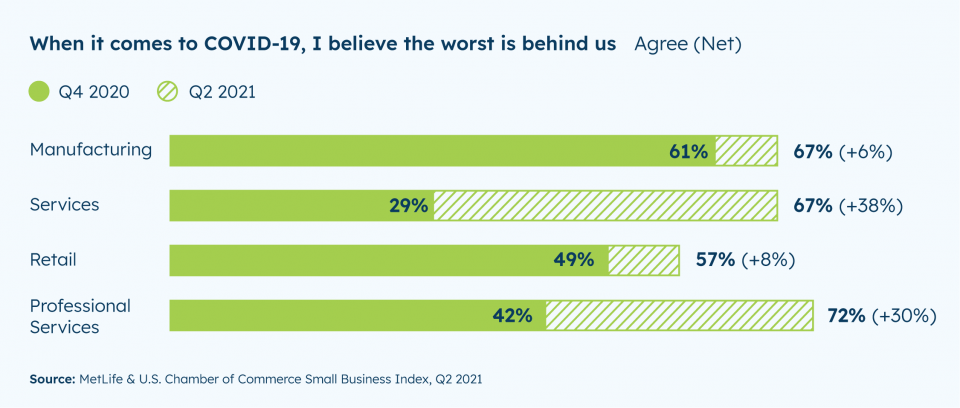The Q2 2021 Met Life and US Chamber of Commerce SBI, released this week, finds that as more Americans received the COVID-19 vaccine, states lift restrictions and businesses continue to reopen, a majority (65%) of small business owners are more optimistic that the worst of the pandemic is over.
According to the poll taken April 21 – May 6th, the dominant emotion small business owners are feeling about their current strategy is hopeful. 31% say they are feeling comfortable and 24% say they are concerned.
“Small businesses are seeing real reasons for optimism this quarter and we’re seeing that reflected in the data,” said Tom Sullivan, vice President of small business policy at the US Chamber of Commerce. “The easing of capacity restrictions due to increased vaccinations means more small businesses are welcoming more customers. Increased foot traffic equates to economic growth and that is moving our country’s recovery forward.
Small businesses are very clear on what will help their businesses thrive: both easing COVID restrictions and more vaccinations. Small businesses say that easing COVID-19 restrictions (29%) and ramping up vaccinations in their area (28%) are the two biggest keys to their success in the remainder of 2021.
When it comes to views of the economy, positive outlooks are growing and negative ones are declining. Currently, 27% of small businesses rate the overall US economy as good, up from 21% who said the same in Q1. Driving this uptick is the decreasing number of small businesses seeing the economy as bad. While 46% continue to say the national economy is poor, this is the first time this measure has fallen below 50% during the pandemic. Just last quarter, 60% of small businesses said the economy was poor.
Additional Findings
Additional survey findings include:
- COVID habits may be here to stay. 76% of small businesses intend to keep all COVID-19 safety precautions in place until the Coronavirus pandemic ends.
- In a tight labor market, employers are holding onto the workers they have. Most small businesses anticipate retaining the same staffing level. 32% plan to increase staffing, and around 11% plan to decrease staffing over the next year.
- Small businesses see revenue improving in the future. About 57% of small businesses anticipate their revenue increasing this year, up 10% compared to last quarter, the most positive outlook of this metric during the pandemic.






















